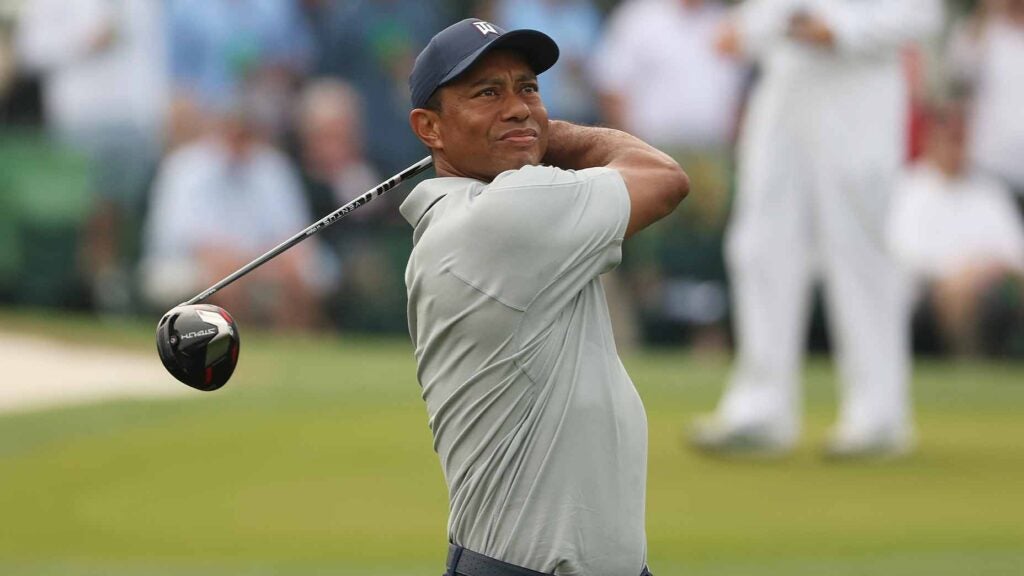AUGUSTA, Ga. — It’s been a while since we last heard Tiger Woods speak.
Long enough that when he arrived at the Augusta National press room on Tuesday morning donning a crisp gray Nike shirt, it was clear to everyone in the room (even those in green jackets) that the conversation would extend far beyond the week’s main event.
With Tiger playing fewer and fewer professional tournaments over the years, his pre-tournament press conferences at the events he does attend have become like earnings calls — an opportunity for Woods to take the temperature of the previous quarter in golf. On Tuesday, that included a few key topics: changes on the PGA Tour, his player pals aging into Champions Tour age, and the most significant development of the sport’s last two months, the golf ball rollback.
The Masters was always a fitting place for Woods to address golf’s distance debate for the first time. After all, it was here some two decades ago that Augusta National and Tiger sparked the debate in earnest. In that year, 2002, the club first changed its golf course to beat back Woods’ prodigious distance gains by adding length to nine holes, an effort that was dubbed “Tiger-proofing.”
Augusta National has done a healthy amount more “Tiger-proofing” in the 21 years since that first effort, though it’s not called by that nickname anymore. The rest of golf has since lapped Woods’ 2002 driving distances, necessitating course “enhancements” that have moved tees back on four more holes in the last two years (Nos. 5, 11, 13 and 15). In all, 14 of Augusta National’s 18 holes have been lengthened a total of 21 times since 2002.
In theory, the change should stop — or at least slow — soon enough. Last month, the R&A and USGA proposed a new rule that would introduce a shorter golf ball for use at professional events. Within the sport, the proposed change has gone over … combatively. Some players have voiced concerns about the changes, while others have gone as far as to outright criticize them.
“It’s evolution,” Justin Thomas said. “I mean, people are running faster, so, what, are they just going to make the length of a mile longer so that the fastest mile time doesn’t change, or are they going to put the NBA hoop at 13 feet because people can jump higher now?”
On Tuesday at Augusta, though, Tiger surprised some when he planted his flag in defense of the new changes, calling himself an “advocate” of the golf ball rollback and the governing bodies’ efforts to address the sport’s distance gains more broadly.
“I think this should have happened a long time ago,” Woods told reporters. “I’ve been of the position if you play in a pro event or you have a P next to your name, you should be playing a pro ball. If you have an A next to your name and you’re playing an amateur event, you should use an amateur ball.”
And, Tiger says, if you needed any further support of his perspective, look no further than the Masters’ brand-new 13th tee.
“Not every golf course can be like Augusta National and move property and moving holes back,” he said. “There’s only so many golf courses you can do that on, and we still want to be able to play the old traditional great golf courses.”
It’s surprising to hear Woods, once the player in golf most adversely affected by Augusta National’s distance changes, now defend the efforts at reining in distance. But there’s a second piece of irony in this whole saga. That golf ball Tiger supports eliminating from the pro game? He was the one who invented it!
It was 2000 when Tiger first used the Nike Tour Accuracy in competition; two years before “Tiger-proofing” would dominate the sport’s conversation. Woods, playing at the Deustche Bank SAP Open in Hamburg, Germany, debuted a new ball of strange origins. Unlike the wound balls used by the overwhelming majority of pros in the day, Woods’ ball was solid in the middle.
Later, we would learn that Woods spent months honing the prototype for the ball with a pair of Nike engineers. But in the moment, the results of that effort were obvious. Tiger, already the best player in the world, had added stunning distance and accuracy gains overnight.
In the months following the Tour Accuracy’s first appearance, Woods would go on to complete the Tiger Slam, winning all four majors in a calendar year. By the time he completed the effort at Augusta National the following spring, all but four players on Tour used a ball made from his construction. The modern golf ball was born.
Now, close to a quarter-century later, the modern golf ball appears poised to die (for pros, at least). If it does, Woods’ comments will be at the center of it. He says he’s okay with that.
“The average number used to be, what, 280 off the tee, 279 when I first came out on Tour?” Woods said. “Now the guys are carrying it 320.”
Change is the way of the world, as our quarterly check-ins with Tiger remind us so frequently. But not at all change is linear.
“I don’t know if Rory shared this,” Woods said. “But yesterday I brought a couple balata balls up here with me and threw them over to him and had him hit a couple putts with them, and he said, ‘Oh my god.’
“I said, ‘Yes, exactly.’ We’re not going to roll the ball back that far, but it’s kind of neat to be able to see the golf ball do different things.”
At the Masters, it’s okay to be wistful of the past. Just not too wistful.
